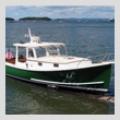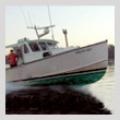Water Ways: Just Say No
Nonpoint source pollution's impact on our waterways
By Melissa Waterman
 Chemicals like these can wash directly from our lawns
Chemicals like these can wash directly from our lawns
into our waterways.
To paraphrase an all-too-common phrase, nonpoint source pollution happens. It’s a depressing type of pollution because, as its name implies, it doesn’t come from one single source, such as a big paper plant, so you can’t really point your finger at one malefactor and say, “Clean up your act!” Nonpoint source pollution comes from the day-to-day things that you do and I do and it has grievous effects on our lakes, streams, and ultimately the ocean.
So what can be done? I began pondering the question when I received an ad flyer from a local business urging me to “Get Ready For Spring!” In order to get my lawn and garden in tip-top shape, the advertisement urged me to buy the following: crabgrass preventer and fertilizer; “weed and feed”; insect control and fertilizer; and lawn fertilizer. Hmm, I thought, that’s a whole lot of pesticide, insecticide, and fertilizer wrapped up in a less-than $40 price tag.
While it’s nice to think that one can have a perfect lawn without a hint of crabgrass, weird white grubs, or the much-maligned dandelion, the reality is that it’s just a fantasy. Still, we are Americans; we believe in perfection through technology, and if the application of chemicals and oil-based fertilizers will hasten the arrival of a horticultural nirvana, most of us will say “Hey! Why not?”
Stop a minute and think about it. The crabgrass preventer and fertilizer are supposed to do two things: make your lawn grow like mad and nuke the crabgrass. But fertilizer makes everything grow, including crabgrass and other weeds. How does that make sense?
The insect control and fertilizer package says that it “kills nuisance pests.” In fact, it kills almost all insects, many of which are necessary to healthy soil. Of course, once you have removed all the insects that made the soil rich in the first place then you really must fertilize your previously fertile soil.
And then there’s the “weed and feed.” Again, the logic of such a combination escapes me. Why feed the lawn a bunch of fertilizer while trying to stifle growth? As it turns out, “weed and feed” is well-known to environmental groups and organic farmers because one of its more noxious elements is an herbicide known as 2,4-D. Apparently 2,4-D had a prior life, as the main component of Agent Orange used to lethal effect during the Vietnam War.
My issue is not necessarily with these products, though their toxicity makes me hesitate to use them. My issue is with us. We don’t know how to care for our land properly. I’ve lived in suburbia where the motto seemed to be “if a little is good, then a lot must be better.” People dumped inorganic fertilizers and god knows what else on their lawns in the belief that huge applications would produce instant green lawns. Nope.
Whatever the grass, trees, and plants can’t absorb simply washes off the land during a rainstorm: that’s nonpoint source pollution. It’s like Vitamin C; your body can only absorb a finite amount of it at any one time. Go ahead and take a zillion milligrams -- the majority of the vitamin will just leave your body via your urinary tract. Likewise, if you dump a bunch of fertilizer and pesticides on your lawn at the wrong time of year or, heaven forbid, just before a rainstorm and the majority of the product will just wash away. In 2001, Maine homeowners purchased a record 1.8 million pounds of lawn care products, double the 1995 figure. Who wants to place a bet on how many of those pounds were carried to the nearest body of water by the rain?
 Lawn chemicals can wash off the grass, onto the street, into the storm drain, and into our lakes or out to sea.
Lawn chemicals can wash off the grass, onto the street, into the storm drain, and into our lakes or out to sea.
Photo by Melissa Waterman
What happens when these fertilizers reach a lake or the ocean? They keep on doing what they were designed to do – promote plant growth. The problem is that the plants that benefit from the added nutrients are plants we don’t like: the enveloping green algae that snuffs out all life in clam flats; the green pond scum that make lakes unappealing for swimming; the tiny marine phytoplankton that bloom uncontrollably at sea, cause a “red” tide, and suck all the oxygen out of the water. You really can’t blame the plants – we feed them handsomely nad they respond.
Lawn and garden pesticides can do a number on water quality as well. Again, if the bugs don’t eat up all the pesticide, the rest of it washes away. At this time of year local lakes are beginning to wake up, with all sorts of life, from spotted salamanders to spring peepers emerging. Juvenile shrimp are about to hatch in sheltered coves along the coast. Cod have spawned. Life is getting under way.
Let’s say that in a few weeks, when we are all industriously strewing “weed and feed” or crabgrass preventer over the lawn, we’re hit with a severe rainstorm. A large proportion of the chemicals applied will be transported inevitably to the ocean. There the pesticides will keep on doing what they are designed to do – eliminate life.
So make a choice this year. Ignore those ads gleaming with green lawns and bounteous gardens. While the purchase price for all those nifty products may seem low, the long-term costs are much too high.
Note: Mowing the lawn is not the most environmentally sound activity one can do either. Sure, it’s what we all do on the weekends but when you get right down to it, those gas- powered lawn tractors and little putt-putt hand mowers drink up a lot of fossil fuel. According to SafeLawns (www.safelawns.org), in the course of a year a one-third-acre lawn will consume five gallons of gas for mowing and trimming plus the equivalent of seven gallons of petroleum in the form of inorganic fertilizers.
What are some alternatives?
» Use an electric or non-powered push mower. Mowing a one-third acre lawn with an electric mower consumes only $3 of electricity during a summer. Non-powered push mowers consume no fuel and make little noise, other than the operator’s huffing and puffing.
» Grow drought-tolerant grasses or other ground covers. Save rainwater from the roof in a cistern or capture the gray water from your sink or washing machine to use in the yard.
Use natural, organic fertilizers not derived from fossil fuels. Recycle grass clippings, set your lawn mower blade higher and water your lawn deeply once a week (if at all), rather than every morning.
If you are reseeding your lawn, consider a no-mow grass mixture. No-mow mix forms a dense turf and will thrive in sun or partial shade. It requires very little water or fertilizer after it becomes established. The mix is made of fine fescues, which are smaller species of grasses. They are slow-growing, narrow-leafed grasses with blades that tend to lie down nearly flat by mid-summer. They are found throughout the cooler states of the northeast and upper midwest. The grasses spread by rhizomes and re-seed well, providing a uniform cover of green grass.

 Chemicals like these can wash directly from our lawns
Chemicals like these can wash directly from our lawnsinto our waterways.
 Lawn chemicals can wash off the grass, onto the street, into the storm drain, and into our lakes or out to sea.
Lawn chemicals can wash off the grass, onto the street, into the storm drain, and into our lakes or out to sea. Photo by Melissa Waterman

Related Articles
Share this article:
2023 Maine Boat & Home Show

Join Us for the Maine Boat & Home Show!
Art, Artisans, Food, Fun & Boats, Boats, Boats
August 11 - 13, 2023 | On the waterfront, Rockland, Maine
Click here to pre-order your tickets.
Show is produced by Maine Boats, Homes & Harbors magazine.















